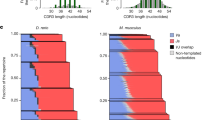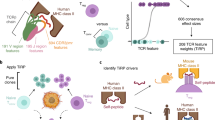Abstract
Natural killer T cells expressing 'invariant' T cell receptor α-chains (TCRα chains) containing variable (V) and joining (J) region Vα14-Jα18 (Vα14i) rearrangements recognize both endogenous and microbial glycolipids in the context of CD1d. How cells expressing an invariant TCRα chain and a restricted set of TCRβ chains recognize structurally diverse antigens is not clear. Here we show that a Vα14i TCR recognized many α-linked glycolipids by means of a 'hot-spot' of germline-encoded amino acids in complementarity-determining regions 3α, 1α and 2β. This hot-spot did not shift during the recognition of structurally distinct antigens, suggesting that the Vα14i TCR functions as a pattern-recognition receptor, conferring on natural killer T cells the ability to sense and respond in an innate way to pathogens displaying antigenic α-linked glycolipids.
This is a preview of subscription content, access via your institution
Access options
Subscribe to this journal
Receive 12 print issues and online access
$209.00 per year
only $17.42 per issue
Buy this article
- Purchase on Springer Link
- Instant access to full article PDF
Prices may be subject to local taxes which are calculated during checkout






Similar content being viewed by others
Accession codes
References
Rudolph, M.G., Stanfield, R.L. & Wilson, I.A. How TCRs bind MHCs, peptides, and coreceptors. Annu. Rev. Immunol. 24, 419–466 (2006).
Bendelac, A. et al. CD1 recognition by mouse NK1+ T lymphocytes. Science 268, 863–865 (1995).
Moody, D.B., Zajonc, D.M. & Wilson, I.A. Anatomy of CD1-lipid antigen complexes. Nat. Rev. Immunol. 5, 387–399 (2005).
Imai, K. et al. Sequence and expression of transcripts of the T-cell antigen receptor α-chain gene in a functional, antigen-specific suppressor-T-cell hybridoma. Proc. Natl. Acad. Sci. USA 83, 8708–8712 (1986).
Lantz, O. & Bendelac, A. An invariant T cell receptor α chain is used by a unique subset of major histocompatibility complex class I-specific CD4+ and CD4−8− T cells in mice and humans. J. Exp. Med. 180, 1097–1106 (1994).
Dellabona, P., Padovan, E., Casorati, G., Brockhaus, M. & Lanzavecchia, A. An invariant Vα24-JαQ/Vβ11 T cell receptor is expressed in all individuals by clonally expanded CD4−8− T cells. J. Exp. Med. 180, 1171–1176 (1994).
Matsuda, J.L. et al. Tracking the response of natural killer T cells to a glycolipid antigen using CD1d tetramers. J. Exp. Med. 192, 741–754 (2000).
Parekh, V.V., Wilson, M.T. & Van Kaer, L. iNKT-cell responses to glycolipids. Crit. Rev. Immunol. 25, 183–213 (2005).
Tupin, E., Kinjo, Y. & Kronenberg, M. The unique role of natural killer T cells in the response to microorganisms. Nat. Rev. Microbiol. 5, 405–417 (2007).
Kinjo, Y. et al. Recognition of bacterial glycosphingolipids by natural killer T cells. Nature 434, 520–525 (2005).
Mattner, J. et al. Exogenous and endogenous glycolipid antigens activate NKT cells during microbial infections. Nature 434, 525–529 (2005).
Kinjo, Y. et al. Natural killer T cells recognize diacylglycerol antigens from pathogenic bacteria. Nat. Immunol. 7, 978–986 (2006).
Zhou, D. et al. Lysosomal glycosphingolipid recognition by NKT cells. Science 306, 1786–1789 (2004).
Gapin, L., Matsuda, J.L., Surh, C.D. & Kronenberg, M. NKT cells derive from double-positive thymocytes that are positively selected by CD1d. Nat. Immunol. 2, 971–978 (2001).
Wei, D.G., Curran, S.A., Savage, P.B., Teyton, L. & Bendelac, A. Mechanisms imposing the Vβ bias of Vα14 natural killer T cells and consequences for microbial glycolipid recognition. J. Exp. Med. 203, 1197–1207 (2006).
Matsuda, J.L. et al. Natural killer T cells reactive to a single glycolipid exhibit a highly diverse T cell receptor β repertoire and small clone size. Proc. Natl. Acad. Sci. USA 98, 12636–12641 (2001).
Liu, Y. et al. A modified α-galactosyl ceramide for staining and stimulating natural killer T cells. J. Immunol. Methods 312, 34–39 (2006).
Miyamoto, K., Miyake, S. & Yamamura, T. A synthetic glycolipid prevents autoimmune encephalomyelitis by inducing TH2 bias of natural killer T cells. Nature 413, 531–534 (2001).
McCarthy, C. et al. The length of lipids bound to human CD1d molecules modulates the affinity of NKT cell TCR and the threshold of NKT cell activation. J. Exp. Med. 204, 1131–1144 (2007).
Gadola, S.D. et al. Structure and binding kinetics of three different human CD1d-α-galactosylceramide-specific T cell receptors. J. Exp. Med. 203, 699–710 (2006).
Kjer-Nielsen, L. et al. A structural basis for selection and cross-species reactivity of the semi-invariant NKT cell receptor in CD1d/glycolipid recognition. J. Exp. Med. 203, 661–673 (2006).
Manning, T.C. et al. Alanine scanning mutagenesis of an αβ T cell receptor: mapping the energy of antigen recognition. Immunity 8, 413–425 (1998).
Park, S.H. et al. The mouse CD1d-restricted repertoire is dominated by a few autoreactive T cell receptor families. J. Exp. Med. 193, 893–904 (2001).
Wang, B., Chun, T. & Wang, C.R. Comparative contribution of CD1 on the development of CD4+ and CD8+ T cell compartments. J. Immunol. 164, 739–745 (2000).
Godfrey, D.I., MacDonald, H.R., Kronenberg, M., Smyth, M.J. & Van Kaer, L. NKT cells: what's in a name? Nat. Rev. Immunol. 4, 231–237 (2004).
Sim, B.C. et al. Surprisingly minor influence of TRAV11 (Vα14) polymorphism on NK T-receptor mCD1/α-galactosylceramide binding kinetics. Immunogenetics 54, 874–883 (2003).
Cui, J. et al. Requirement for Vα14 NKT cells in IL-12-mediated rejection of tumors. Science 278, 1623–1626 (1997).
Godfrey, D.I., McCluskey, J. & Rossjohn, J. CD1d antigen presentation: treats for NKT cells. Nat. Immunol. 6, 754–756 (2005).
Gumperz, J.E. et al. Murine CD1d-restricted T cell recognition of cellular lipids. Immunity 12, 211–221 (2000).
Zajonc, D.M. et al. Structure and function of a potent agonist for the semi-invariant natural killer T cell receptor. Nat. Immunol. 6, 810–818 (2005).
Cantu, C. III, Benlagha, K., Savage, P.B., Bendelac, A. & Teyton, L. The paradox of immune molecular recognition of α-galactosylceramide: low affinity, low specificity for CD1d, high affinity for αβ TCRs. J. Immunol. 170, 4673–4682 (2003).
Brossay, L. et al. CD1d-mediated recognition of an α-galactosylceramide by natural killer T cells is highly conserved through mammalian evolution. J. Exp. Med. 188, 1521–1528 (1998).
Koch, M. et al. The crystal structure of human CD1d with and without α-galactosylceramide. Nat. Immunol. 6, 819–826 (2005).
Rauch, J. et al. Structural features of the acyl chain determine self-phospholipid antigen recognition by a CD1d-restricted invariant NKT (iNKT) cell. J. Biol. Chem. 278, 47508–47515 (2003).
Gumperz, J.E. Antigen specificity of semi-invariant CD1d-restricted T cell receptors: the best of both worlds? Immunol. Cell Biol. 82, 285–294 (2004).
Borg, N.A. et al. CD1d-lipid-antigen recognition by the semi-invariant NKT T-cell receptor. Nature 448, 44–49 (2007).
Brigl, M. et al. Conserved and heterogeneous lipid antigen specificities of CD1d-restricted NKT cell receptors. J. Immunol. 176, 3625–3634 (2006).
Gadola, S.D., Dulphy, N., Salio, M. & Cerundolo, V. Vα24-JαQ-independent, CD1d-restricted recognition of α-galactosylceramide by human CD4+ and CD8αβ+ T lymphocytes. J. Immunol. 168, 5514–5520 (2002).
Sidobre, S. et al. The Vα14 NKT cell TCR exhibits high-affinity binding to a glycolipid/CD1d complex. J. Immunol. 169, 1340–1348 (2002).
Cunningham, B.C. & Wells, J.A. Comparison of a structural and a functional epitope. J. Mol. Biol. 234, 554–563 (1993).
Borg, N.A. et al. The CDR3 regions of an immunodominant T cell receptor dictate the 'energetic landscape' of peptide-MHC recognition. Nat. Immunol. 6, 171–180 (2005).
Lee, P.U., Churchill, H.R., Daniels, M., Jameson, S.C. & Kranz, D.M. Role of 2CT cell receptor residues in the binding of self- and allo-major histocompatibility complexes. J. Exp. Med. 191, 1355–1364 (2000).
Sidobre, S. et al. The T cell antigen receptor expressed by Vα14i NKT cells has a unique mode of glycosphingolipid antigen recognition. Proc. Natl. Acad. Sci. USA 101, 12254–12259 (2004).
Tynan, F.E. et al. A T cell receptor flattens a bulged antigenic peptide presented by a major histocompatibility complex class I molecule. Nat. Immunol. 8, 268–276 (2007).
Schumann, J., Mycko, M.P., Dellabona, P., Casorati, G. & MacDonald, H.R. Cutting edge: influence of the TCR Vβ domain on the selection of semi-invariant NKT cells by endogenous ligands. J. Immunol. 176, 2064–2068 (2006).
Andersen-Nissen, E., Smith, K.D., Bonneau, R., Strong, R.K. & Aderem, A. A conserved surface on Toll-like receptor 5 recognizes bacterial flagellin. J. Exp. Med. 204, 393–403 (2007).
Bell, J.K., Askins, J., Hall, P.R., Davies, D.R. & Segal, D.M. The dsRNA binding site of human Toll-like receptor 3. Proc. Natl. Acad. Sci. USA 103, 8792–8797 (2006).
Kinjo, Y. & Kronenberg, M. Vα14i NKT cells are innate lymphocytes that participate in the immune response to diverse microbes. J. Clin. Immunol. 25, 522–533 (2005).
Bendelac, A. & Medzhitov, R. Adjuvants of immunity: harnessing innate immunity to promote adaptive immunity. J. Exp. Med. 195, F19–F23 (2002).
Arden, B., Clark, S.P., Kabelitz, D. & Mak, T.W. Mouse T-cell receptor variable gene segment families. Immunogenetics 42, 501–530 (1995).
Arden, B., Clark, S.P., Kabelitz, D. & Mak, T.W. Human T-cell receptor variable gene segment families. Immunogenetics 42, 455–500 (1995).
Seibel, J.L., Wilson, N., Kozono, H., Marrack, P. & Kappler, J.W. Influence of the NH2-terminal amino acid of the T cell receptor α chain on major histocompatibility complex (MHC) class II + peptide recognition. J. Exp. Med. 185, 1919–1927 (1997).
White, J., Pullen, A., Choi, K., Marrack, P. & Kappler, J.W. Antigen recognition properties of mutant Vβ3+ T cell receptors are consistent with an immunoglobulin-like structure for the receptor. J. Exp. Med. 177, 119–125 (1993).
Huseby, E.S., Crawford, F., White, J., Marrack, P. & Kappler, J.W. Interface-disrupting amino acids establish specificity between T cell receptors and complexes of major histocompatibility complex and peptide. Nat. Immunol. 7, 1191–1199 (2006).
Acknowledgements
We thank J. Cambier, P. Henson, E. Huseby and R. Torres for discussions and comments on the manuscript; J. Loomis for assistance with flow cytometry; and the National Institutes of Health core facility for CD1d tetramers. The GSL-1′ compound was provided by M. Kronenberg and Y. Kinjo (La Jolla Institute for Allergy and Immunology); the mouse stem cell virus–based retroviral plasmids with a human nerve growth factor reporter were provided by S. Reiner (University of Pennsylvania); and B78hi cells were provided by H. Levitski (Johns Hopkins University). Supported by the National Institutes of Health (AI057485 to L.G., AI18785 to P.M. and AI17134 to J.K.), the Howard Hughes Medical Institute (P.M. and J.K.), the Australian Research Council Federation (J.R.), the National Health and Medical Research Council (J.M. and J.R.; Peter Doherty Fellowship to N.A.B.), the Cancer Council of Victoria (J.M. and J.R.) and the American Cancer Society (J.L.M.).
Author information
Authors and Affiliations
Contributions
J.P.S.-B., J.L.M., T.M. and L.G. did the experimental work and analysis and prepared the manuscript; J.W., N.A.B., J.M. and J.R. provided reagents and crystallographic data; and J.P.S.-B., J.K., P.M. and L.G. devised the project, analyzed the data and wrote the manuscript.
Corresponding author
Ethics declarations
Competing interests
The authors declare no competing financial interests.
Supplementary information
Supplementary Text and Figures
Supplementary Figures 1–4 (PDF 1191 kb)
Rights and permissions
About this article
Cite this article
Scott-Browne, J., Matsuda, J., Mallevaey, T. et al. Germline-encoded recognition of diverse glycolipids by natural killer T cells. Nat Immunol 8, 1105–1113 (2007). https://doi.org/10.1038/ni1510
Received:
Accepted:
Published:
Issue Date:
DOI: https://doi.org/10.1038/ni1510
This article is cited by
-
Single-cell RNA sequencing identifies shared differentiation paths of mouse thymic innate T cells
Nature Communications (2020)
-
TCRα-TCRβ pairing controls recognition of CD1d and directs the development of adipose NKT cells
Nature Immunology (2017)
-
Mutation of the Traj18 gene segment using TALENs to generate Natural Killer T cell deficient mice
Scientific Reports (2016)
-
Atypical natural killer T-cell receptor recognition of CD1d–lipid antigens
Nature Communications (2016)
-
The CD1 family: serving lipid antigens to T cells since the Mesozoic era
Immunogenetics (2016)



